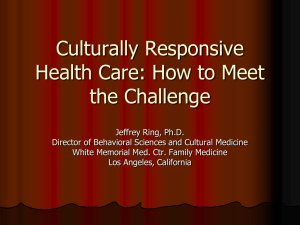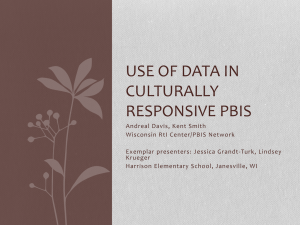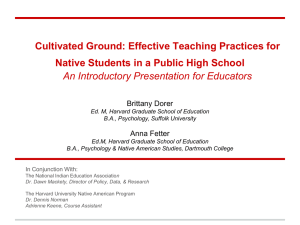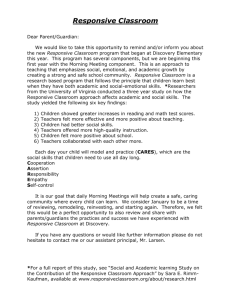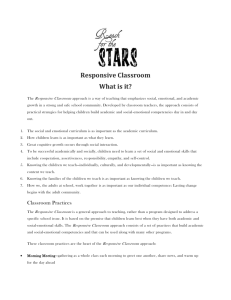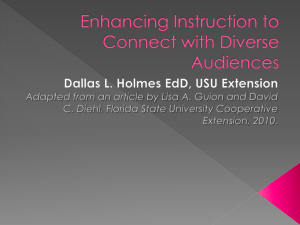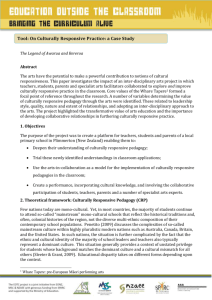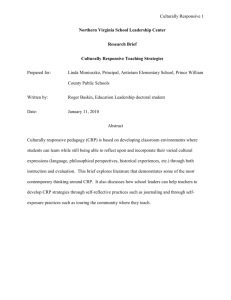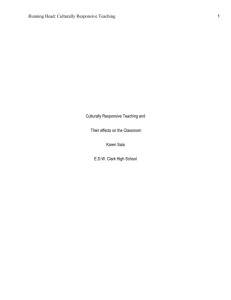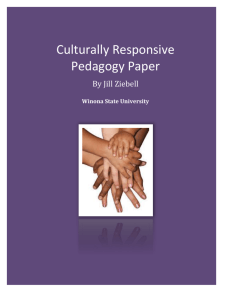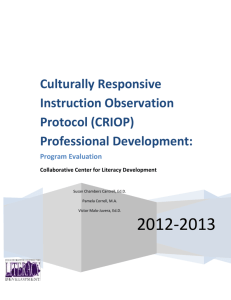Running Head: CULTURALLY RESPONSIVE TEACHER The Role
advertisement
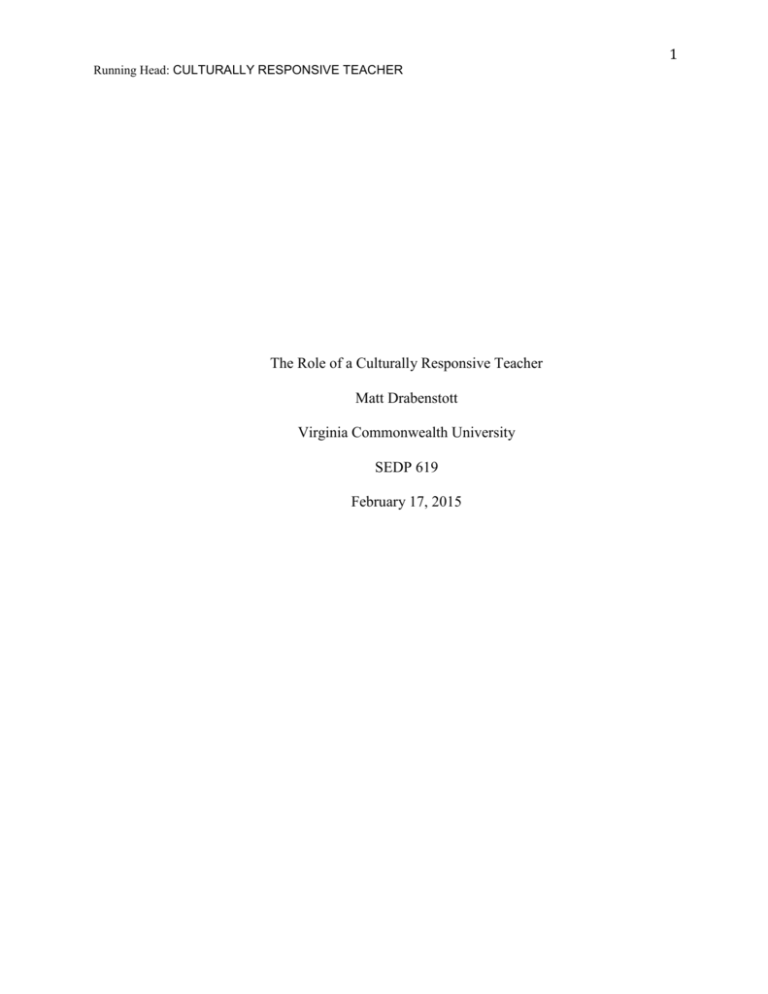
1 Running Head: CULTURALLY RESPONSIVE TEACHER The Role of a Culturally Responsive Teacher Matt Drabenstott Virginia Commonwealth University SEDP 619 February 17, 2015 2 Running Head: CULTURALLY RESPONSIVE TEACHER The role of a culturally responsive teacher begins with understanding the incredibly diverse population of students found in the classroom. Embedded in what defines a diverse learner are the variables which shape the learner’s identity. These variables can be broken into intrinsic natural and extrinsic environmental qualities. These qualities both work conjointly to define the diverse learner. Before examining environmental variables, it is important to look at some of the factors each individual inherently possesses. For example, some students are born with different learning styles. These styles can be a mixture of auditory, visual, or kinesthetic. These learning styles may remain consistent or alter in time. Physical and mental barriers are crucial to consider when defining the diverse learner. Physical impairments, such as: lack of sight, hearing, or muscular control, can hinder or alter the way a student learns. Not all impairments are visible. Some students may have more “invisible” challenges such as: psychiatric illnesses, intellectual disabilities, or learning disabilities. Sometimes physical and mental impairments are inherent to the student from birth, but they can also crop up later in the learner’s life. The array of abilities and impairments each learner is born with can ultimately determine what teaching supports a teacher will need to implement for each student’s academic success. A student’s learning needs also evolve over time due to environmental impressions. According to Bronfenbrenner’s (1979) Ecological Systems Theory, every person grows and develops their own intricate identity within the confines of various external pressures and impressions. Outside of innate characteristics of each person, such as health, age, and sex, other aspects of one’s identity are formed through various environment systems. These environmental subsystems can include: family, peers, school, church, neighbors, mass media, and other social 3 Running Head: CULTURALLY RESPONSIVE TEACHER attitudes regarding culture. These external environments are extremely informative to a student’s cultural lens. Understanding the diverse learner is the first step a teacher must take in order to provide correct educational supports. As a culturally responsive teacher, it is imperative to strive to “peel back” each student’s formative layers and uncover their educational needs. This requires teachers to take on investigative and listening role. Although listening may seem to be a secondary quality that teacher’s need to posses, teachers must actively seek out opportunities to understand each student. These opportunities may manifest as parent-teacher conferences, IEP meetings, or carving out time after class to speak to a student one-on-one about which teaching styles are working well for the student. Going the extra mile in student’s life, like attending extracurricular activities, well help a teacher understand a student, but also clue students into their teacher’s sense of care. After becoming attuned to each student’s identity, academic need, and cultural lens from listening, a teacher can then tailor their teaching style and curriculum to meet each student’s learning style. Adopting a Universal Design Learning methodology by differentiating content representation, engagement, and expression in lessons will also help educate to a student’s learning need. A teacher who knows his/her audience well will enable him/her to explain curriculum content in ways that resonate with each student’s frame of reference. Geneva Gay (2010) expresses this idea in a powerful way when she explains that culturally responsive teaching is effective because it makes, “learning encounters more relevant…[by building] bridges of meaningfulness between home and school experiences” (p.31). Becoming a culturally responsive teacher stretches beyond simply understanding student culture. The culturally responsive teacher must also seek to understand his/her own identity and 4 Running Head: CULTURALLY RESPONSIVE TEACHER cultural paradigm. This process is difficult because it requires the teacher to assume an objective view of their identity—awareness about what experiences and environments weave into shaping one’s identity. A dialogue with other teachers and exposure to other cultures will aid in this understanding of a teacher’s own identity. This process is important because it reveals any biases or prejudices that a teacher might bring to the classroom. Removing biases cultivates more respect to the dignity of differences between cultures found in a classroom, therefore increasing the probability that a student’s cultural background will be a strength at school. Each student brings a very unique cultural and ethnic perspective to the classroom. As a culturally responsive teacher, it is vital to understand the intricate inherit and environmental factors which influence the learner’s strengths and needs. Through this listening process, and an introspective look at one’s own identity, the culturally responsive teacher is able to build bridges of meaning in student’s lives and leverage student strengths to overcome barriers. 5 Running Head: CULTURALLY RESPONSIVE TEACHER References Bronfenbrenner, U. (1979). The Ecology of Human Development: Experiments by Nature and Design. Cambridge, MA, 383-385. Gay, Geneva. (2010). Culturally Responsive Teaching: Theory, Research, and Practice, New York: Teachers College Press, 31.
